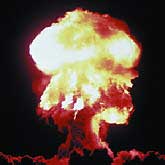The Truth About Atomic And Hydrogen Bombs

Without the intervention of a moderating medium, the process can go on in an uncontrolled manner. Each instance of a nucleus splitting apart and emitting a particle releases a certain amount of energy. When the amount of material present is more than a certain threshold quantity, or 'critical mass', so many particles and so much energy are released that the chain reaction runs wild. This is the process of 'nuclear fission' that defines an atomic bomb. The same process, but using a good moderating medium, allows the controlled release and capture of the same energy, which is the basis of the nuclear power generating station. The incident at Chernobyl some years ago stands as a grim reminder of the close kinship between the destructive force of the atomic bomb and the constructive generation of electricity in the nuclear reactor.
In 1953, people watched the testing of the first hydrogen bomb with some fear. For the first time in history, a force was to be purposely unleashed over which man had no control whatsoever and that served no purpose other than destruction. There was a fear that the detonation of that first bomb would also initiate the destruction of the world. This fear was based on the exceedingly small but finite probability that the explosion of this bomb would initiate an unstoppable chain reaction in the most common element in the world: hydrogen. Their fears were perhaps not totally unfounded, as a rumor persists that the energy liberated by that bomb exceeded the very best theoretical calculations by as much as twenty percent, begging the question 'where did it come from?'. And yet, this amazingly destructive force also presents a source of hope for mankind. Research continues to look for a way to harness the incredible power produced by the nuclear fusion process. Success would mean abundant cheap energy for the whole world to use.
About the Author
Richard M J Renneboog, MS
 Richard M. J. Renneboog is an independent private technical consultant and writer in both chemical and computer applications. Endeavors have included preparation of scripts for instructional and promotional video, corporate website design, curriculum development for training in advanced composites technology, and development.
Richard M. J. Renneboog is an independent private technical consultant and writer in both chemical and computer applications. Endeavors have included preparation of scripts for instructional and promotional video, corporate website design, curriculum development for training in advanced composites technology, and development.


